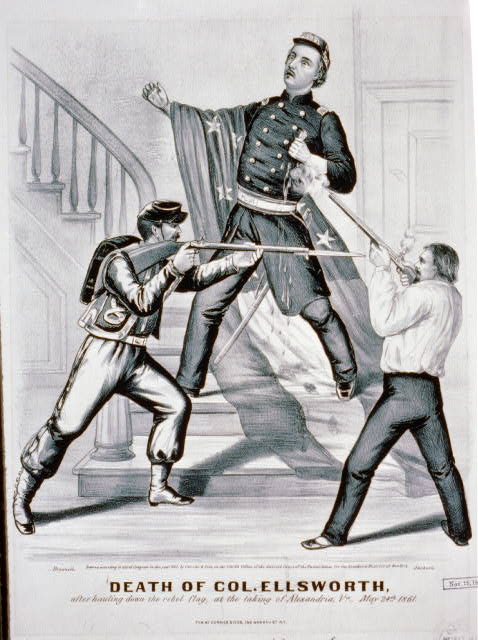By the time of the Fort Sumter crisis in April 1861, seven Southern states had seceded from the Union, but not Virginia. Her loyalties were still undecided. While very few Virginians supported Lincoln and the Republicans, many considered secession too rash and pressed for a peaceful solution to the crisis. But after Sumter, the debate effectively ended. Just three days after the fort surrendered, on April 17, the Virginia Secession Convention passed its Ordinance of Secession, to widespread public approval.
That same afternoon, one particularly enthusiastic secession advocate, James W. Jackson, attracted a large crowd on the corner of King and Pitt Streets by hoisting a large Confederate flag from the roof of the Marshall House hotel. He had only owned the hotel since January, but his loyalties were well known. The flag was massive, 14-foot-by-24-foot, large enough to be visible from the White House, and Jackson publicly claimed that "whoever should attempt to remove it, would have to pass over his dead body."
To be ratified, the Ordinance of Secession required a statewide popular vote, scheduled for May 23. On the day of the vote, by Lincoln's order, a force of 10,000 federal troops (volunteer regiments from New York, New Jersey and Michigan) assembled in the District and prepared for a military incursion into Virginia. The voters of Virginia passed the Secession Ordinance by a margin of 3 to 1. (In Alexandria, the margin was almost 9 to 1.) That night, at about 1:30 AM on the morning of May 24, federal troops began marching across the Long Bridge from D.C. into Virginia. At the same time, other regiments crossed the Potomac by way of the Aqueduct Bridge (one mile to the north) and by boat.
 |
| Courtesy of Wikipedia |
By dawn, most of the Alexandria militias had evacuated the city, federal troops were securing the vital Orange & Alexandria Railroad depot, and Ellsworth was leading his regiment to secure the telegraph station. As they marched through the city, Ellsworth noticed the great Confederate flag flying over the Marshall House, and decided to remove it. Accompanied by four of his troops, he burst through the doors of the three-story hotel, marched to the top floor, and pulled down the huge flag.
As he descended the stairs, flag in hand, James W. Jackson met them at the third floor landing and shot Ellsworth in the chest with an English-made double-barreled shotgun. Ellsworth was killed instantly, and in retaliation, his fellow Zouave Corporal Francis E. Brownell immediately shot Jackson in the face with a .58 caliber percussion rifle.
 |
| Courtesy of Wikipedia |
Alexandria would remain an occupied city, under a state of martial law, for the duration of the Civil War, longer than any other community in the Confederacy.
Tomorrow I will discuss our recent visit to the Fort Ward Museum & Historic Site, which is currently hosting an exhibition on the Marshall House Incident, and I will post photos of some of the more interesting artifacts.
No comments:
Post a Comment